Bottom-tier Character Tomozaki is a Japanese light novel series that has been adapted into two anime seasons, with the first airing in winter season 2021 and the second airing in winter season 2024. I previously included the first season in my 2021 anime year-end review as a notable mention and wrote a (late) full review of the season. The second season, Bottom-tier Character Tomozaki 2nd Stage, aired for 13 episodes from January 3, 2024 through March 27. In my review, of season one, I foreshadowed that I would review season two. You will find my season two review below.
Prefatory notes on spoilers
This is my first review of a non-first season anime here at The New Leaf Journal. When I am reviewing initial (or only) seasons, I try to write reviews as spoiler-free as possible in order that they can be instructive to people who may be interested in trying the series. In this case, watching the second season of Tomozaki requires familiarity with the first (or, at a minimum, the underlying novel source material). Thus, this review follows from my season one review and presupposes familiarity with Tomozaki. If you are not familiar with the series, I recommend at least reading my Tomozaki season one review before this article. That applies as well to readers who may be interested in reading my thoughts on the series who are sure they will not watch it.
My discussion of the second season itself will be somewhat more detailed in certain respects than some of my previous anime reviews. The second season can largely be broken into three story arcs. I will describe what the three arcs are and their central conflicts but will refrain from describing precisely how they are resolved. I do not think my review will unduly spoil the second season for people who intend to watch it (my approach is more cautious than some other reviews I came across), but readers who already know for certain that they will watch the second season may consider doing so before reading my review.
I plan to write a separate post including my analysis of some specific plot points in the second season that will contain spoilers. I will update this passage and the introduction to this article with a note after I publish that piece.
Anime Details
Bottom-Tier Character Tomozaki 2nd Stage is, like the first anime season, based on an ongoing light novel series by Yuuki Yaku. The 11th volume of the novel series was released on January 18, 2024. I believe the second season adapts material through the 7th volume of the novels.
| English Anime Title | Bottom-Tier Character Tomozaki 2nd Stage |
| Japanese Title | Jaka Chara Tomozaki-kun 2nd Stage |
| Aired | January 3, 2024 through March 27, 2024 (13 episodes) |
| Studio | Project No.9 |
| Director | Shinsuke Yanagi |
| Based On | Manga by Yuuki Yaku |
| Links | Wikipedia. ANN. MAL. AniDB. |
Crunchyroll holds the license for both seasons of Tomozaki in North America.
Brief Recap
I incorporate by reference the entirety of my description of Tomozaki’s plot in my season one review. Below, I will briefly re-introduce the characters and discuss the ending of season one in slightly more detail than what I wrote in my previous review.
Dramatic personae
All of the characters except Tsugumi Narita are in Fumiya Tomozaki’s 11th grade class. Most of the characters are called by their first names by some characters and last names by others. Because Tomozaki almost always uses last names, I default to that for all characters except Mimimi and Tama, who go by their nicknames.
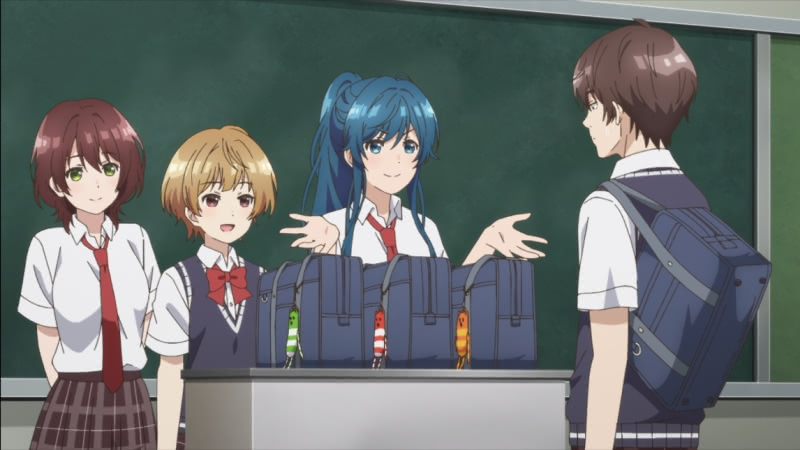
- Fumiya Tomozaki (voiced by Satou Gen). Tomozaki is the protagonist and sole view-point character of the series. He is the best Attack Families (fictional Super Smash Brothers) player in Japan but begins the series as a disheveled, unhappy young man with no friends. He meets Aoi Hinami (voiced by Hisako Kanemoto), his popular classmate who, unbeknownst to Tomozaki , is the second-best Attack Families player in Japan. Hinami challenges Tomozaki to engage in life in the same way he plays games. He takes Hinami up on her offer to teach him and throughout the first season uses Hinami’s lessons and quests to improve his appearance and social skills and make friends.
- Aoi Hinami (voiced by Hisato Kanemoto): Hinami is the most respected girl in the school in which the anime takes place. She is charismatic, athletic, and academically inclined. She is also very competitive and makes a point of being the best at everything, only coming in second place in Attack Families (her passion for games is only known to Tomozaki). It is thanks to Hinami that Tomozaki improves himself and his quality of life, but it becomes clear late in the season that everything Hinami does is so carefully choreographed and scripted that Tomozaki begins to question who the real person is behind all Hinami’s masks. We also learn that Hinami is not actually happy and cannot articulate any specific end or objective to her drive to be successful.
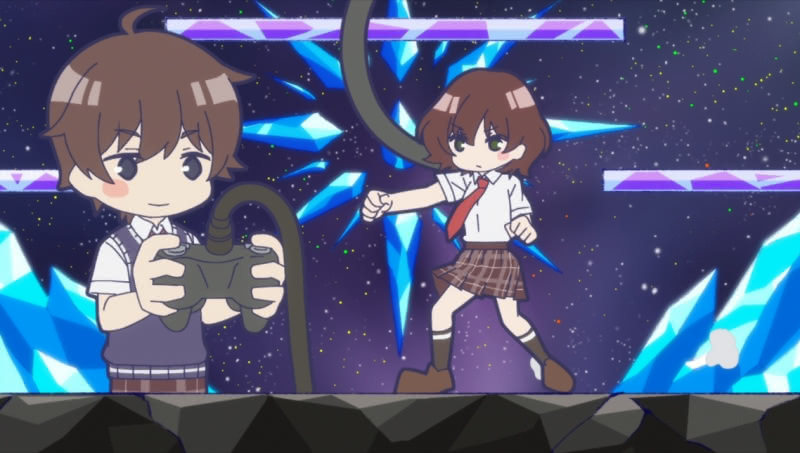
- Yuzu Izumi (voiced by Nene Hidea): A pretty girl who sits next to Tomozaki. He befriended her pursuant to an early assignment from Hinami, and he helped her in her quest to win the heart of their surly (but not a bad guy) classmate, Shuuji Nakamura (voiced by Nobuhiko Okamoto).
- Minami “Mimimi” Nanami (voiced by Ikumi Hasegawa): An attractive, athletic, and energetic (perhaps too energetic) girl who is in eternal second place to Hinami. She became one of Tomozaki’s first friends. Tomozaki worked as her campaign manager when she challenged Hinami for the position of student council president (Hinami assigned him to do that). While Mimimi lost, the experience made her and Tomozaki good friends and she confided in him about her inferiority complex. Tomozaki also became acquainted with Mimimi’s best friend, the small, blunt, and true-to-herself Hanabi “Tama” Natsubayashi (voiced by Ryouko Maekawa).
- Fuuka Kikuchi (voiced by Ai Kayano). Kikuchi is a shy, bookish aspiring author. She appeared to have noticed Tomozaki before his transformation. Hinami designated Kikuchi as Tomozaki’s love interest and pushed Tomozaki to spend time with her. She and Tomozaki became friends because they found it easy to talk to one another, and their relationship improved when Tomozaki tried to be more true to himself. They went on a few quasi-dates but Tomozaki ultimately declined to go further because something about Hinami’s assignment felt off to him. He took on the role of reading Kikuchi’s draft novels and offering critiques.
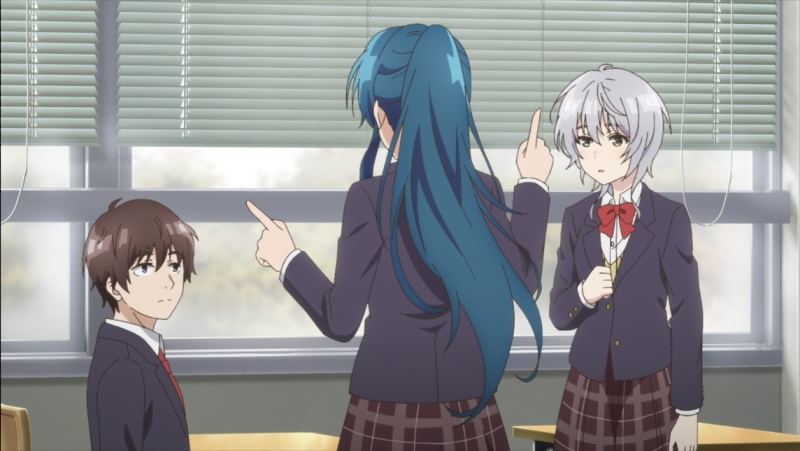
- Takahiro Mizusawa (voiced by Nobunaga Shimazaki): He is tall, attractive, and suave – in some ways the male Hinami, but without Hinami’s extreme facade. He becomes Tomozaki’s first guy friend and seems to have some idea of what Tomozaki is trying to accomplish. He gives Tomozaki some helpful advice. Tomozaki witnesses Mizusawa confess his feelings to Hinami late in the first season only to be robotically rejected by Hinami as if she were reading from a script (he seemed to expect that outcome). Tomozaki takes a part-time job at the karaoke center where Mizusawa works between seasons. Tsugumi Narita (voiced by Akane Fujita), a lazy, low-energy 11th grade student from a different school, is their co-worker (Narita plays a minor role in the second season but is never at the center of events).
Additional notes on ending of first season
Most of the first season consisted of Tomozaki completing Hinami’s quest and making new friends as he improved himself along the way. The final arc of the first season brought Tomozaki and Hinami into conflict. Hinami pressed Tomozaki to get a girlfriend and designated Kikuchi, who she (almost certainly correctly) perceived had been interested in Tomozaki even before his transformation. Tomozaki got along well with Kikuchi – albeit better when he decided to be himself than when he relied too heavily on Hinami’s lessons. He declined to ask Kikuchi to be his girlfriend because it did not feel right to him. Hinami accused Tomozaki of giving up. Tomozaki could not allow things to end like that – so after thinking about their disagreement, he explained to Hinami that he wanted to use what she had taught him for an end beyond “winning” in and of itself – to actually enjoy life and pursue what he wanted. Hinami was unconvinced of Tomozaki’s idea but she could not run from his proclamation that he would turn the tables on her and show her that life can be fun.
While the end of the first season highlighted the different perspectives of Tomozaki and Hinami (note: the only reason Tomozaki was in position to think about what he wanted from life was because Hinami had inspired him to actually take an interest in the world), they re-established their student-teacher dynamic going into season two. Moreover, Tomozaki also takes a part-time job (one of Hinami’s first post-conflict tasks) at a karaoke center with Mizusawa and a new season two character (not in the same school), Tsugumi Narita. However, as I noted in the previous sub-section, both Tomozaki’s part-time job and Narita play relatively minor roles in the second season.
My Review
Below, I present my review of the second season of Tomozaki. The structure will be a little bit different than my initial/only season reviews because of this season’s dependence on the first.
Aesthetics
To begin, I incorporate by reference most of my assessment of the aesthetics from my review of season 1 of Tomozaki. Season 2, like season 1, has decidedly average production values and limited animation. The quality is variable. Some episodes have relatively good animation – 1, 5, 8, and a couple toward the end are good examples off the top of my head.
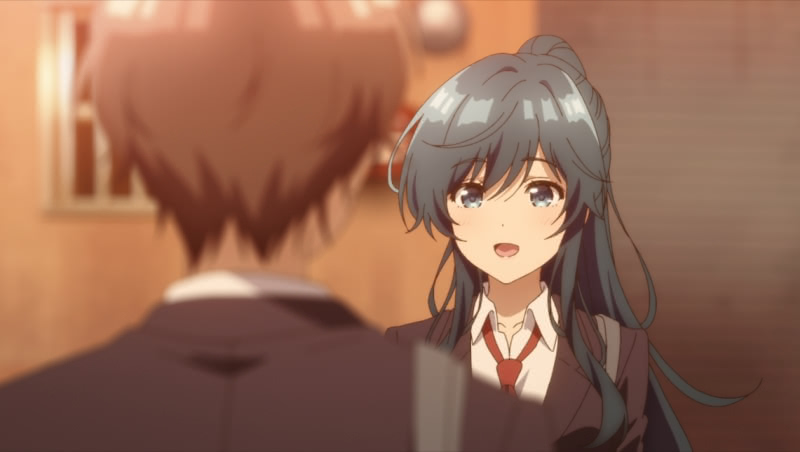
The production values of season two are slightly better than season one in that it saves up its resources for some big scenes – including the scene of the series thus far and what will stand as one of the better scenes of 2024 in one of the middle episodes. There are also a number of storybook-style scenes in the final arc that are among the prettiest (from an animation stand-point) of either season (granting that they are distinctly short on animation).
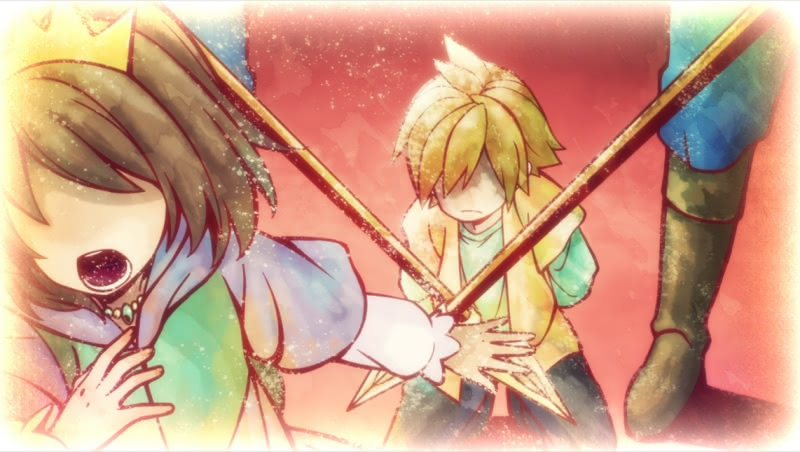
But some episodes are of lesser quality – for example I noticed a distinct dip from episode 1 to 2. There are examples of off-model characters and awkward cuts in its weaker animated episodes. Moreover, Tomozaki features many one-on-one conversations which quick, simple cuts focused on a single character (even in its most detailed episodes) which do little to inspire the imagination. Much like the first season – Tomozaki is much more about the story than the cinematography.
(I noted in my season one review that the camera had an awkward tendency to linger on Hinami’s and Mimimi’s legs. This remains true in the second season with respect to Hinami, but the peculiar cinematography is mostly limited to her in this go-around and, as I will explain, Hinami has much less screen-time in season two than in season one.)
I did not have strong feelings about the opening or ending songs and animation, but the ending was decent and accompanied by fun (and occasionally changing) visuals.
General Story Structure
The second season of Tomozaki has three main story-arcs:
- Bullying Arc: Tomozaki is tasked by Hinami with making Erika Konno (voiced by Sayaka Kaneko), a pretty but unpleasant girl in their class, enthusiastic about the school’s sports festival. Tomozaki succeeds, but the festival triggers a dark turn in Konno stemming from her learning that Nakamura, who she is attracted to (that was a minor story-line in the first season), is dating Izumi. Konno and her clique end up taking out their annoyance on Tama, and Tama turns to Tomozaki for help.
- Transitional Arc: Tomozaki returns to fulfilling Hinami’s quests as he reconciles what happened in the bullying arc and begins to look forward to the next major event of the school year.
- Love Triangle Arc: Hinami instructs Tomozaki to think about which two girls he may be interested in dating. One of the two obvious girls forces the issue. This occurs against the backdrop of the school cultural festival. Tomozaki, pursuant to Hinami’s orders, takes a leading role in his class’ cultural festival plans while working through his unexpectedly complicated love life.
Below, I will offer my brief impression of all three arcs.
The bullying arc
The bullying story technically starts mid-way in the second story, but Tomozaki’s cultural festival task leads into it. Konno seems to be the second most influential girl in the class after Hinami, but she has little interaction with Tomozaki because she has her own clique. For that reason, Hinami’s directing Tomozaki to get Konno excited for the cultural festival is tricky (note: there are some underlying reasons Hinami came up with this specific task but they are beyond the scope of the review). The first episode is one of the better episodes of the season and we see Tomozaki’s growth in that he can rely on the friends he made in the first season to give him advice and help him indirectly.
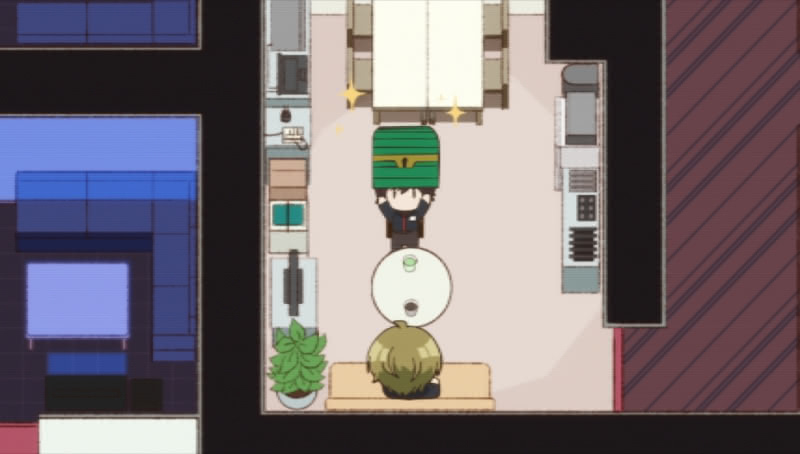
Tomozaki “succeeds” in the assigned task – but everyone miscalculated in that part of the implicit motivation he gave to Konno to enjoy the festival was for her to look good in front of Nakamura, who was now dating Konno’s friend, Izumi. I will note here that the second season dropped the ball by only noting that Izumi and Nakamura began dating in passing, both because Izumi’s courtship of Nakamura was a significant plot point in the first season and it plays a key role in the ugly situation that develops early in the second.
Konno felt humiliated by the Nakamura-Izumi revelation , and she (along with her flunkies) takes out her anger by bullying a passive, minor character (typically by kicking her desk as they walked by and general unpleasantness). Tomozaki almost intervenes but Hinami warns him off. However, Tama, who has few friends, a strong moral compass, and no fear of saying what was on her mind, intervenes. This only causes Konno and her minions to begin bullying Tama instead. Unlike the first target, Tama stands up for herself – but Tama’s willingness to fight Konno perversely turns the class against her for poisoning the mood.
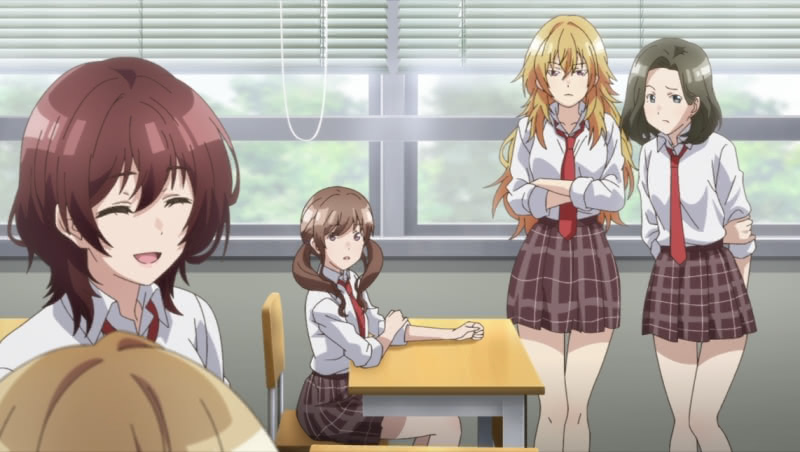
Hinami, who had befriended Tama in the past and helped Tama become friends with Mimimi, is unexpectedly angry about this but does not directly intervene. Mimimi, Tama’s best friend and self-appointed protector, also does not intervene but is upset and feels helpless about the situation. Tomozaki wonderswhether it may be better for Tama to lay low until Konno becomes bored.
Tama has a different idea. She was not close with Tomozaki (their only somewhat meaningful conversations came during Mimimi’s student council election arc in the first season), but she notices how much he had changed over the past few months. She asks Tomozaki to help her change in the same way. Tama explains that she could live with Konno’s bullying but it bothered her to see Mimimi upset about it. She is also aware that one reason the class was turning against her was because she has no friends other than Hinami, Mimimi, and perhaps Tomozaki to a lesser extent. She thought if she could be more social and get along with people better, it would improve her situation in the class and in turn help Mimimi. Tomozaki decides to help her. However, Hinami is oddly opposed to the idea and said she would deal with things in her own way – which causes her and Tomozaki to agree to put their lessons on hold while the conflict continued.
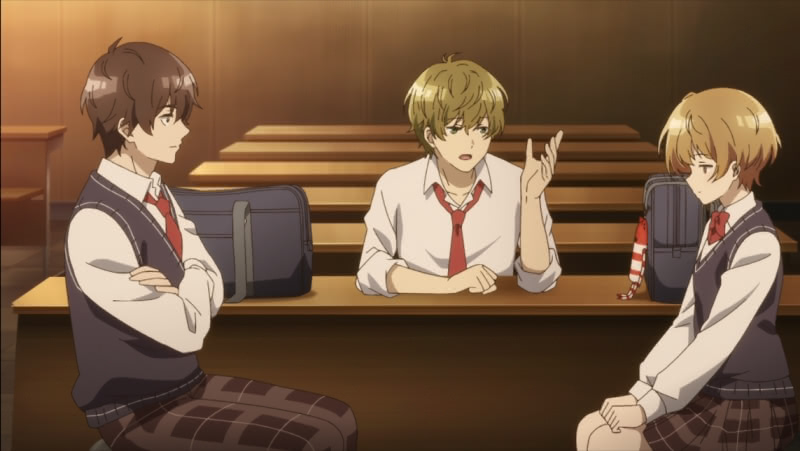
The better part of three episodes are devoted to Tomozaki helping Tama improve her social skills. He adapts what he learned from Hinami to help Tama speak in a more friendly way and make jokes to lighten the mood. Tomozaki brings in his friends – chiefly Mizusawa but also Izumi, Kikuchi, and Mimimi, to help Tama. Tama applies what she learns from Tomozaki to good effect and begins ignoring Konno, which helps reverse the sympathies of some of her classmates.
A certain event brings the bullying arc to a head – namely by triggering Hinami, who had been acting separately from Tomozaki, to take action. I will not go into detail other than to note that Hinami’s approach to resolving the arc, while perhaps not initially wrong, makes Tomozaki uncomfortable in a way that only Mizusawa seems to understand. Tama is able to use everything she had learned to good effect, but the main take-away from the conclusion of the arc unsurprisingly ends up being about Tomozaki and Hinami. It sets up some interesting points about Hinami that are ultimately not resolved in the second season.
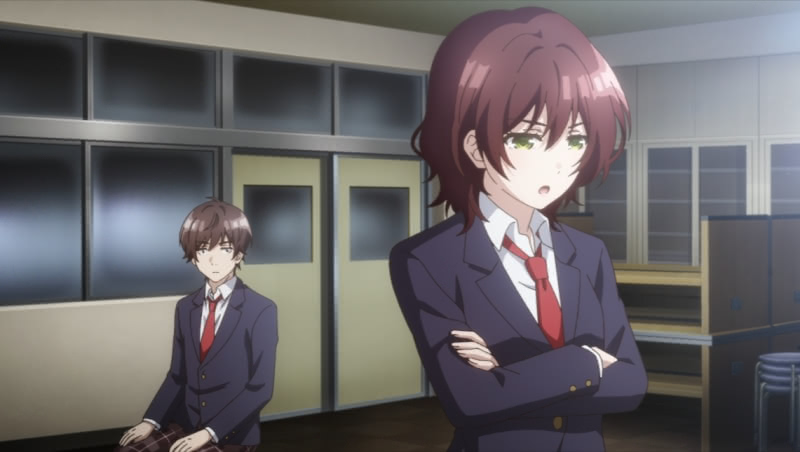
Bullying is a difficult topic to cover in anime. Lest I am misunderstood, I do not mean difficult from a sensitivity perspective; I mean that bullying requires strong character writing to handle the topic well. Even some otherwise excellent shows, such as the first season of My Teen Romantic Comedy SNAFU (“Oregairu”), struggle to credibly deliver a compelling story about bullying. The only anime that comes to mind when I think of outstanding treatment of bullying is the second season of March Comes in like a Lion (2017-18). March’s bullying arc was not only great but perhaps the best sequence of moments and episodes of the entire decade in anime. In light of the fact that Tomozaki’s best writing is not on par with either of the series I referenced above, I had a foreboding feeling when I saw it was going all in on a bullying story. My concerns turned out to be well-founded, although the arc did feature some significant character development.
The two most significant issues in the arc were pacing and story-telling. The pacing was off for the entire arc. Some points – such as the introduction of the bullying story in episode 2 or the first episode’s decision to skip over how Izumi and Nakamura began dating felt rushed. Another point that was rushed was Tomozaki himself. He went from initially almost intervening on behalf of a girl he barely knew to deciding, before Tama asked for his help, that it may be time to wave the white flag. This happened within the span of a single, rapidly-moving episode, and I felt a distinct sense of whiplash at the time. While I thought that having Tomozaki become teacher to Tama’s student was a solid idea, the actual execution dragged on too long (at least two entire episodes), and I came away with the feeling that the anime could have handled it more economically and used the free time to develop more important matters. The story was heavy-handed in how it depicted the behavior of the class. My issue was not that no one outside of Tama and perhaps Kikuchi acquitted themselves perfectly in the arc – high schools are not courage factories and the point that few people were going to go out on a limb for someone who had never been particularly friendly is not unrealistic. The problem had to do with how the writers chose to highlight one theme of the arc: Controlling the class mood. It is one thing for students to be petty and wishy-washy but another for them to turn on a dime every time a more socially dominant character says or does something. There was no subtly in depicting the class mood. The issue may have been a lack of writing aptitude, time constraints, or not trusting the audience to pick up on nuance. The heavy-handed writing made its worst impression in the climax of the arc, which lessened the impact of what was the most dramatic scene of the series to that point.
Granting my complaints, the arc did do some things well. Tama came off well as a character. In the first season her main purpose was to have Mimimi cling to her. Here we see that she is a strong person who needed a small push to make friends. Mizusawa’s central role in the arc was notable and did a good job of highlighting his significance as Tomozaki’s only close guy friend. It reminded me that Hinami had made a point of telling Tomozaki that he needed some male friends (her early tasks guided him into making friends with girls from her friend group). The arc’s use of Kikuchi was significant in that, while Kikuchi spent plenty of time with Tomozaki in the first season, she had very little on-screen interaction with anyone else. This was the first time we saw Kikuchi meaningfully interact with people other than Tomozaki. Finally, Mimimi, who indirectly inspired Tama to change, came off more credibly as a character in the arc (even with Tama) than she did for much of the first season.
Of course – the main take-away from the Tama arc was ultimately a new fissure in the strange Tomozaki-Hinami relationship, but the nature of that is a bit beyond our scope.
The interlude
Tomozaki and Hinami resume their lessons after a break during the bullying arc. While they disagreed on almost everything during the bullying arc – Hinami with Tama’s determination to change despite not having done anything wrong and Tomozaki with some aspects of how Hinami brought affairs to a close – they continued on as normal after airing their differences of opinion. Hinami tasked Tomozaki with starting a social media account and taking specific pictures – which I discussed in an article on social media in anime.
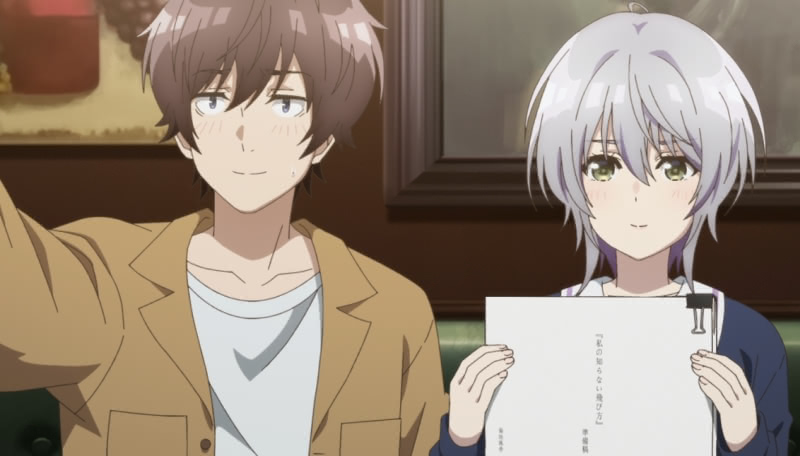
We also see Tomozaki spend time alone with Mizusawa outside of the context of their high school (this story involves the only somewhat significant new character, Tsugumi Narita).
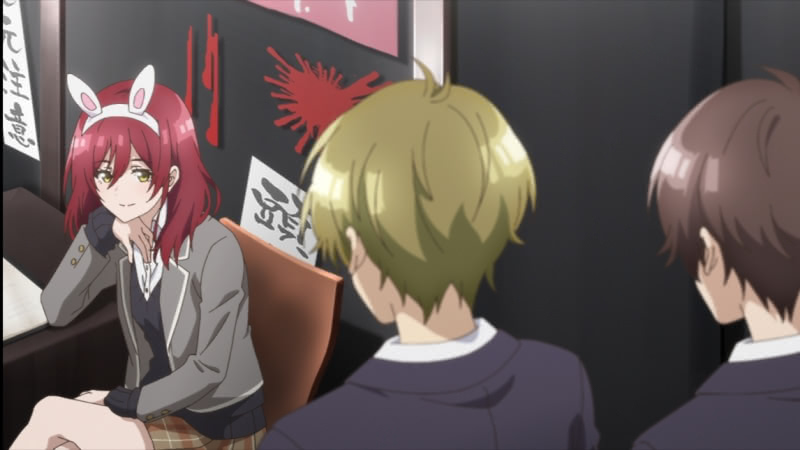
Episode 7 is a stand-out episode in that it develops the increasingly important Tomozaki-Mizusawa friendship, sets up a key conflict for the following arc, and generally recaptures the charm of the first season.
The love triangle and culture festival
Hinami modified her long-standing task for Tomozaki to get a girlfriend (although the task had led to their conflict at the end of season one, it remained on the assignment board – without specifically naming Kikuchi – throughout season two). Instead of trying to prod him into asking Kikuchi out like she did in the first season or instructing him to get any girlfriend as she does for most of the second, Hinami instead tells Tomozaki to consider two girls he would be interested in dating and get closer to them. Hinami then uses the upcoming school cultural festival as a time limit – telling Tomozaki to ask someone out by the end of that major event (anime loves confessions in school festivals).
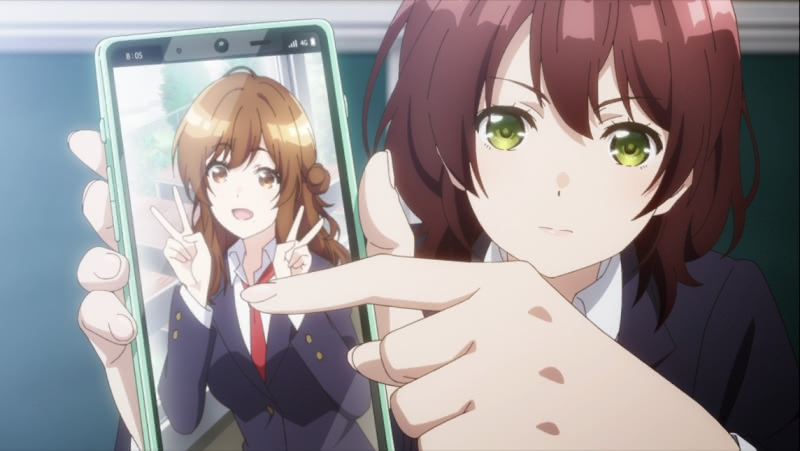
Tomozaki wis uneasy but he does not reject the task out of hand. With respect to the cultural festival itself, Hinami instructs Tomozaki to go all out and do everything he could to make the festival a success. This was an interesting task for Tomozaki since Hinami herself would be largely preoccupied with her student council work.
One party to the love triangle should be obvious to anyone who read this far. While Tomozaki did not ask Kikuchi out in the first season, she remained the girl he was closest to other than Hinami, and they became closer yet during the second season.
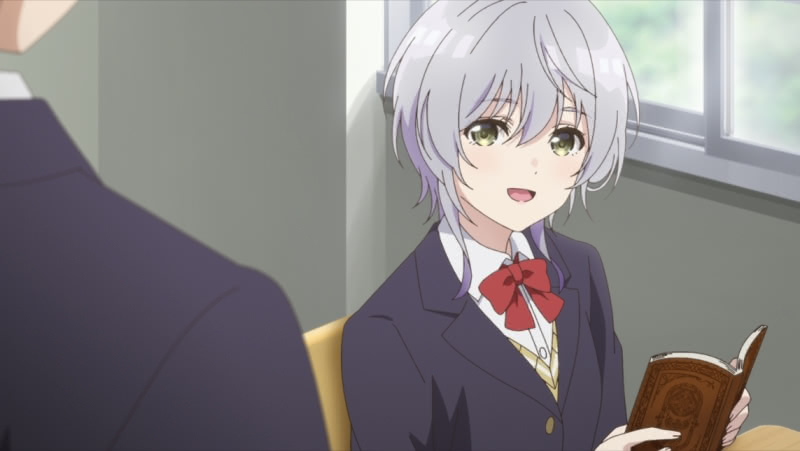
I will not disclose the other party to the love triangle other than noting that it was not Hinami and the identity of the girl was foreshadowed on multiple occasions in the first half of the season. I will also note – without saying who wins – that the love triangle is actually resolved with finality at the end of the second season, meaning we are not left with a cliffhanger. While Tomozaki may have had some doubts about finding a girlfriend under Hinami’s timeline, a certain event, which is highlighted in the best scene of the series thus far, effectively puts Tomozaki on a timer even without the particulars of Hinami’s task.
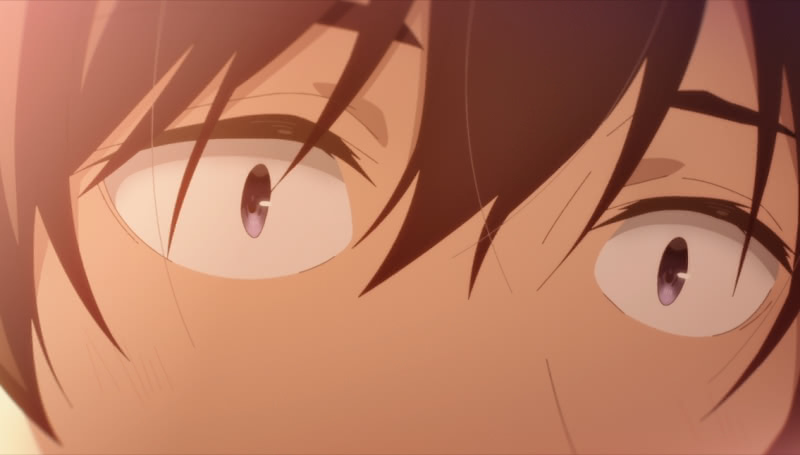
The love triangle and cultural festival stories blend together. While Tomozaki is preoccupied with (A) trying to imagine himself having a girlfriend and (B) the new reality that he could actually have a girlfriend, he does not forget Hinami’s cultural festival task. Tomozaki shows his character growth by volunteering for a leading role in the cultural festival planning, guiding the class to put on a play, and choosing the play while playing an indispensible role in its planning and production. Tomozaki had demonstrated while serving as Mimimi’s campaign manager in season one that he was competent, well-organized, and could understand people so long as he was not the focus of said people. The cultural festival serves as the next step in his development. In this case, he has to stand in front of a class instead of helping Mimimi behind the scenes. While he certainly did not have the same stage presence as a Hinami, Mizusawa, or even Mimimi, the arc gave Tomozaki the cleanest opportunity to show his dramatic progress from the beginning of the season.
The class-play topic ultimately ties into Tomozaki’s love triangle dilemma in a very obvious way. While managing the production of the play, which involves one of Tomozaki’s two love interests, he is also helping the other love interest with an unrelated project.
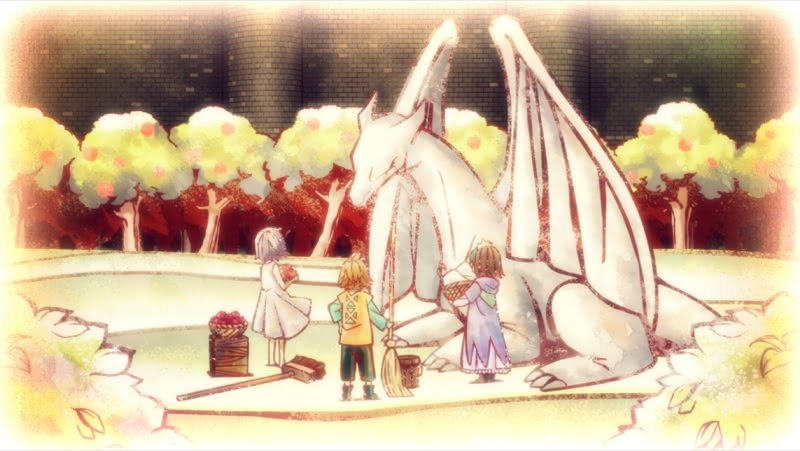
While Hinami does not play a role in helping the class plan the cultural festival, she is cast in the class play. That leads to Tomozaki being tasked with learning more about Hinami. Interviewing Hinami, who never shows her true feelings, proves to be predictably uninformative. Fortunately, Hinami authorizes Tomozaki to talk to people who had been her classmates before high school. That interview leads to some important revelations about Hinami’s past (granted not any different than what Hinami had implied to Tomozaki in season one) and family (likely very significant, albeit not developed in the season). Tomozaki also has his first significant disagreement with Kikuchi, not necessarily directly related to the love triangle. The disagreement implicates some of the views that Tomozaki has begun cultivating late in the first season, and it inspires Tomozaki to carefully consider his own perspective in order to resolve the philosophical disagreement with Kikuchi. I will note that the issue is related to Tama’s in the first arc (how one wants to live rather than bullying, to be clear).
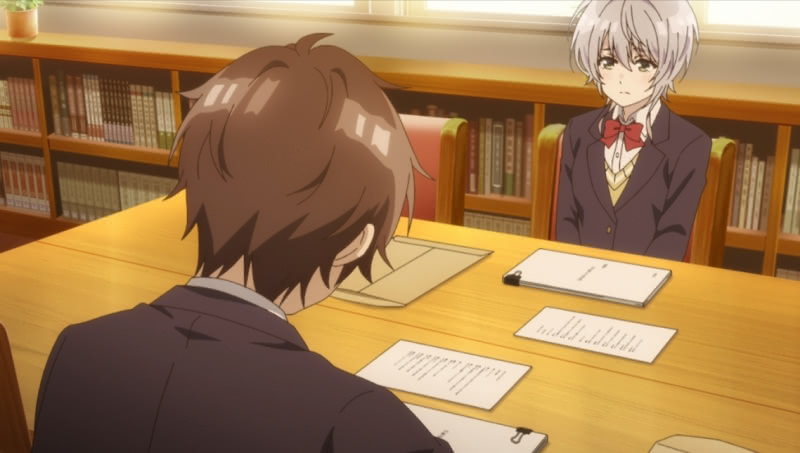
As I noted above – the main plot points – the love triangle and the cultural festival, are both fully resolved by the end of the final episode of the second season.
The love triangle-cultural festival arc has its hiccups, but it is more compelling than the bullying arc in the first half of the season.
While this arc, like the bullying arc, includes some heavy-handed story-telling, I will give it its due for how it sets up the love triangle. The series has yet to explain why Hinami is personally iso nvested in Tomozaki’s having a girlfriend, but her decision to modify her prompt to have Tomozaki focus on two girls instead of one was, for a careful viewer, less contrived than one might expect. The series does more than enough to show without telling that Hinami had caught on to the fact that someone other than Kikuchi was interested in Tomozaki and that Tomozaki was going to have to address the issue sooner rather than later. While Hinami’s determination to force Tomozaki to go out with Kikuchi seemed arbitrary in season one, the set up in season two was implicitly prompted by external circumstances.
The season also does a good job in highlighting one of Tomozaki’s central hang-ups with romance. The two seasons take place over the course of several months in a single school year. While it feels like a long time to viewers, Tomozaki had been a disheveled loner not long before the events of the end of season two. At that time the idea of having a girl interested in him would have seemed absurd. Tomozaki is not dense – he was aware of the signs that Kikuchi was interested in him at the end of the first season – but the idea did not feel real to him. Prior to the cultural festival, the series focused on having it made clear to Tomozaki that no one, including girls, saw him as the same person he had been going into the series. The event that lights the fuse for the conclusion of the love triangle forces Tomozaki to acknowledge to himself that someone like him could be in a relationship.
The pacing is better in the love triangle-culture festival arc than in the bullying arc, but it still had significant issues. I liked the way that the show linked the writing of the class play to Tomozaki’s love conflict to a point. As Tomozaki assists in writing the play, the show uses very aesthetic picture-book style images with narration to tell the play’s story. The play’s connection to Tomozaki’s life is always obvious. My issue is that, as with Tama’s tutoring, the show spends too much time on it. I lost track of precisely how many times we are shown a different version of the play. By the time we see Tomozaki’s class actually watching the play, I felt like I had seen the same thing – with minor variations – many times. The reason of course is because I had in fact seen it many times. Similarly to Tama’s arc, problems related to slow pacing are compounded of slow pacing in one part of the story leads to rushing other, potentially more important parts of the story. The worst effect of this was on Tomozaki’s philosophical conflict with Kikuchi. The show rushes through explaining the conflict and then rushes through resolving it in such a way that it is never clearly explained and one has to lean heavily on the overall context of the show to put together what the issue was and Tomozaki’s peculiar, under-developed solution. We could have sacrificed a little bit of the play-versioning detail for a better account of an important character disagreement. While I grant that Hinami’s issues are not ripe for resolution in the material covered by season two, it felt off to devote time to Tomozaki learning about her past but no meaningful time to Tomozaki thinking about one important thing he learned – especially in light of the fact that, love triangles aside, Hinami remained the single most important influence on Tomozaki.
The elephant in the room here is the conclusion to the love triangle. I gleaned from Crunchyroll comments and at least one review of part of the series that many viewers had strong, negative opinions about the outcome – specifically which girl won (I suppose winning depends on whether one considers Fumiya Tomozaki a catch). My interest in love triangles tends to be more in whether they are resolved in ways that make sense within the context of the story than what I would do if I were the 2D person at the center of the love triangle. To that extent – Tomozaki made the choice I would have expected him to make in a vacuum, and in that sense I did not have an issue with it. Was it the most interesting possible choice? Perhaps not. But it made sense. Granting that, I think the series planted some seeds for it not being the f final final choice, and I will note that one of my central predictions articulated in my first season review with respect to the ultimate resolution of Tomozaki’s love life remains unchanged.
While I was fine with the outcome of season two’s love triangle, I do have some issues with how we got there beyond the issues articulated in the previous paragraph. While the series does an excellent job of showing how Tomozaki struggled with imagining himself as someone who could be in a relationship, it could have done more to articulate his feelings about the two girls who were interested in him – especially the “loser” (again – mileage varies) of the love triangle. I have my own view of when Tomozaki made his choice, but the show left too much to the imagination. That ties into a more serious issue. In light of the reasons why Tomozaki rejected Hinami’s Kikuchi task in season one, I would have expected the show to spend more time having Tomozaki consider his feelings for the girls. It largely neglected that until the ultimate resolution and left one with the feeling – probably unintended – that the main change from season one was Tomozaki’s self-confidence. This may be a symptom of the fact that, notwithstanding the love triangle plot, the main point of Tomozaki is not romance. Nevertheless, since Tomozaki himself put the emphasis on genuine feelings in season one – the build up to the romantic resolution in season two was underwhelming in some respects.
For those who actually watch the second season, I wrote my spoiler-filled thoughts on the love triangle in a separate post.
Conclusion
While the second season of Tomozaki returned the same production team and cast, it has a very different feel. The first season was more lighthearted and focused on Tomozaki’s self-improvement. The second season presents us with a more self-sufficient Tomozaki and more drama. While I appreciated some of the plot development – pacing and writing issues rendered the second season the weaker of the two thus far.
The second season significantly changed the focus. While Hinami continued to be the biggest influence on Tomozaki and played a significant role in both major story arcs, her actual screen-time was dramatically reduced from the first season. Conversely, Tama, Mizusawa, Mimimi, and Kikuchi all saw their roles dramatically increase – and none disappointed. I single out Mimimi for special mention. I found her grating in many of her appearances in season one and, while her own two-episode arc was solid and rounded out her character, I thought it was heavy-handed at times. However, season two toned down some of Mimimi’s grating tendencies from the first season and the writers showed much more command of her character than of anyone else in the cast with the possible exception of Tama.
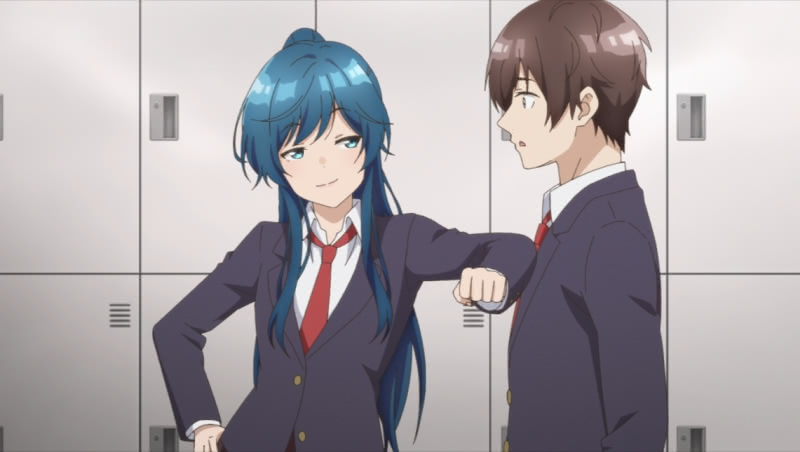
Two issues were primarily responsible for dragging the second season below the first. The first issue was pacing – both in bludgeoning viewers with repetition with respect to the Tama tutoring and the play set-up and neglecting or speed-running through other important plot points. The second issue is more difficult. The second season took on some heavier plot lines than the first, and there were points where the writing quality – the ability to express things clearly while assuming that the audience is intelligent enough to pick up on nuance – was too often where it was necessary. I wrote in my season one review that I saw writing issues in the first season that potentially limited the series’ anime upside. It again hit against some of those limitations in the second season. Whether the script issues derive from the source material or from specific choices that were made in adapting it to anime I know not – albeit I suspect some pacing issues stemmed from questionable decisions on the adaptation side. I hope that a potential third season (there may likely enough novel material to support one as is) pays more careful attention to pacing and assumes a more intelligent audience than did the second.
Nothing about the second season modifies my qualified recommendation of the first. It should go without saying that since I thought the first season was better on the whole, the second season does not make me more likely to recommend the first, but I would recommend the second season to people who enjoyed the first. Despite my disappointment in some regards, I like most of Tomozaki’s cast and I would be interested in future seasons – specifically to see how the series ultimately answers the ever-increasing list of questions about the impulses and motivations of Aoi Hinami.